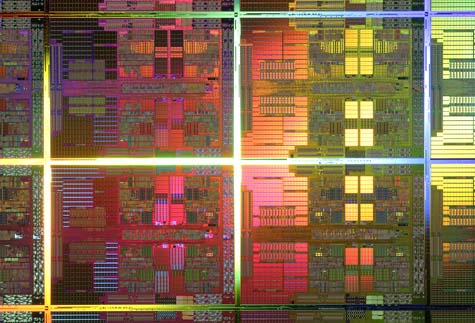Decoding AMD's 45nm processor announcement

After a dismal 2007, AMD is trying to regain its footing. The company made several technology announcements at a computer tradeshow in Hannover, Germany last week--including progress on 45nm processors. But it remains to be seen whether AMD can deliver on all of this, and be more competitive in 2008.
In the past week or so, AMD has announced:
- A new graphics chipset, the AMD 780, for desktops and notebooks
- Working demonstrations of notebooks using its Puma platform due in the second quarter
- An updated graphics driver (Catalyst 8.3) that supports multiple AMD GPUs on Windows Vista
- A milestone in the use of new type of lithography for manufacturing future microprocessors
The most significant news, however, was the demonstration of desktops and servers based on 45nm Deneb and Shanghai processors, respectively, running multiple operating systems and different applications.

A photo of a wafer showing AMD's 45nm processors. Source: AMD.
Semiconductor companies design and manufacture processors with smaller and smaller features because it lets them cram more transistors on a chip, reduce power consumption and lower production costs. Intel is currently shipping 45nm Penryn processors for servers, desktop and laptops, while AMD uses 65nm process technology even on its latest K10 (aka Barcelona) processors. So AMD is racing to catch up.
Based on AMD's 45nm timeline, The New York Times reported the company was closing the gap with Intel by shrinking the time it takes to shift to a new generation, or "node," to 12 to 18 months. That's possible, but not likely. AMD released its first 65nm chips, dual-core Athlon 64 X2 processors, in December 2006. It plans to release the first 45nm processors sometime in the second half of this year, which means the actual transition could be as short as 18 months, but more likely it will be closer to 24 months.
That's still impressive--about the same as Intel's vaunted tick-tock strategy--but it won't necessarily close the gap with a very tough rival. Last week, Intel gave an update on its process technology at an annual conference for financial analysts. So far the company has shipped 3.5 million 45nm processors and by the third quarter, it will be shipping more Penryns than 65nm chips. (Though Intel announced Penryn last November, those were mostly server chips, and it wasn't until CES in January that 45nm desktop and laptop processors really got rolling.) To underscore how fast Intel is moving, CEO Paul Otellini told the audience he was giving his presentation on a PC using a Nehalem processor--those aren't due to ship until late 2008--and that work on the 32nm and 22nm generations was on track.
The planned roll-out of Intel's 45nm Penryn processors. Source: Intel.
Then there's the fine-print on AMD's 45nm announcement. AMD promises its 45nm chips will deliver a 20% performance boost through the use of strained silicon and an ultra low-k dielectric. (A dielectric is a layer of material that insulates the metal wires that connect transistors to improve performance and reliability.) But a separate FAQ notes that the ultra low-k dielectric will actually be used on "some later 45nm products," not the ones AMD demonstrated. And the new gate materials (metal and high-k dielectrics) found in Intel's Penryn are a 'future option' on AMD's 45nm processors to "further enhance transistor performance." That's curious since IBM announced more than a year ago that working with AMD, Sony and Toshiba it had developed the high-k/metal gate technology for use in 45nm products starting in 2008.
It's also interesting to note what AMD apparently did not mention at the CeBIT tradeshow: No Phenom 8000 series triple-core processors--due by the end of this month--and no updates on the new versions (the B3 stepping) of the quad-core Phenom--either low-power parts also due by the end of this month or ones with faster clock speeds due sometime in Q2. That doesn't necessarily mean they will be late. It could simply be that AMD has already left embattled Barcelona behind--from a PR standpoint--and is focusing on future technology.
But as AMD executives have admitted, what the company needs to do this year is make fewer promises, and ship more products. If it can deliver on a very aggressive roadmap for 2008, it will lead to more choices in desktops and laptops.